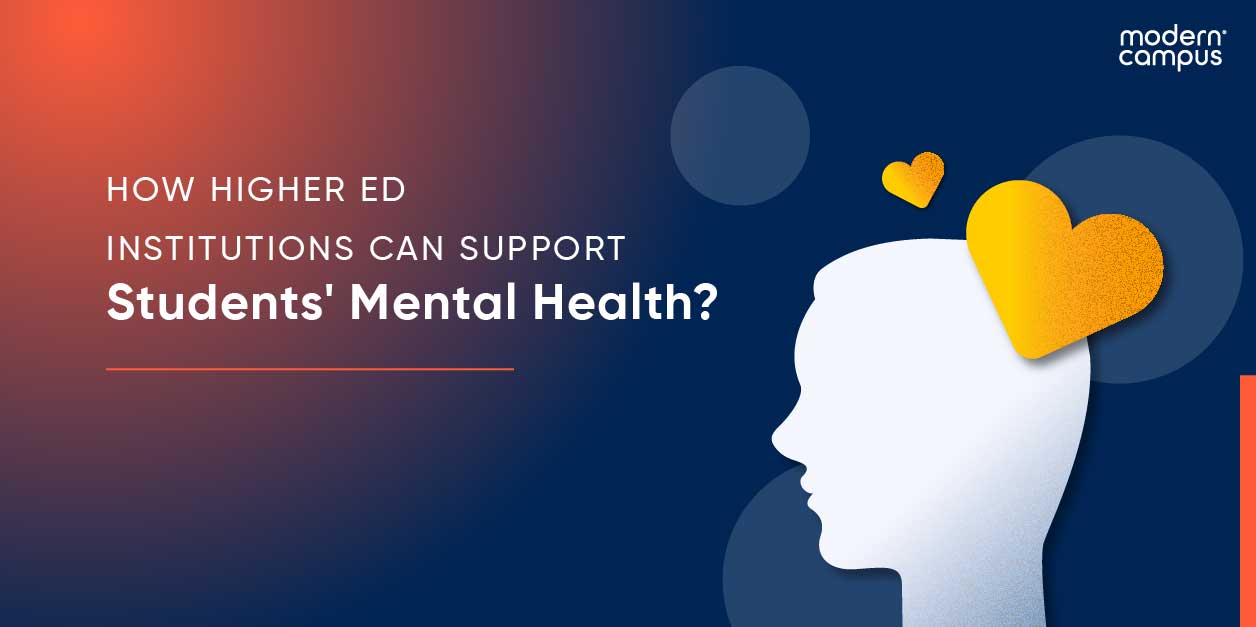Improving Student Mental Health within Higher Education
Investing in students’ mental well-being is not only a moral imperative for colleges and universities; it’s also essential for each institution’s long-term health.
A 2019 study by the American Council on Education found that students with poor mental health are more likely to have lower GPAs, take longer to complete a degree, or drop out entirely.
An institution that doesn't address its students’ mental health may struggle to maintain strong retention and persistence rates, as well as fulfill its mission to graduate confident lifelong learners.
Why do college students struggle with mental health?
Supporting student mental health in higher education is a growing priority. The National Institute of Mental Health reports that one in four American adults suffer from a diagnosable mental illness in a given year, with most disorders emerging before age 25. Approximately 18 percent have an anxiety disorder, and 9.5 percent experience depression.
Given that individuals enrolled in higher education programs represent a diverse cross-section of the population, it’s no surprise that many students struggle with mental illness. Plus, in addition to categorizable illnesses, many more adults deal with acute stress born from challenging life circumstances. And higher education—as exciting, rewarding, and invigorating as the experience can be, on campus and off—brings many such challenges.
Higher education is often accompanied by academic stressors, financial worries, and social isolation, along with other transitional challenges explored below, all of which affect students' well-being.
Factors affecting student mental health in higher education
Although mental illness is often genetic and unavoidable, external factors can exacerbate stress, anxiety, and depression. Here are four of the top situational elements found to influence learners’ well-being.
Academic Pressure: In addition to putting pressure on themselves, many students feel pressure from their families, prospective employers, and peers to excel academically. Students who responded to a 2023 survey conducted by Inside Higher Ed said that academic “pressure to do well” is their second biggest stressor behind exams. Other top stressors include balancing school with other obligations, essays/papers, getting a bad grade, homework, pressure to pick a career, and group projects—in that order.
Financial Stress: High tuition costs, student loan debt, and the cost of living can create significant financial stress. Housing insecurity and food insecurity are also on the rise among students. Uncertainty about the future affordability of enrollment and life necessities can lead to poor mental health among students.
Social Isolation: High education can be a lonely and isolating experience for many students, especially learners who live away from home or are disconnected from their usual support systems. A 2017 study found that up to 45 percent of students experience moderate or severe homesickness, and two-thirds of students responding to a 2020 survey reported feeling socially isolated.
Transition Challenges: Higher education marks a significant life transition for students of all ages and academic programs—from 18-year-olds starting full-time undergraduate degree tracks to adult learners enrolled in Continuing Education programs. Transitions are tricky to navigate, and the resulting stress is often associated with sleep deprivation, eating disorders, academic burnout, and substance abuse. Students may also struggle to maintain healthy relationships with their families, friends, and romantic partners.
How can colleges and universities improve student mental health?
It’s not reasonable to expect any institution to cure students of every last worry. But the following practices can cultivate happier environments in person and online while helping learners develop healthy coping skills that support academic persistence and holistic wellness.
Provide counseling and therapy
Offering accessible mental health services on campus and online is a vital step toward addressing the psychological needs of students. Counseling center services can include individual and family therapy, support groups, anxiety management, roommate mediation, substance abuse education, nutrition counseling, teletherapy, and peer-led hotlines.
In order for these mental health initiatives to make a meaningful impact, students must feel encouraged to use them. To that end, institutions should also invest in promoting these services and reducing stigmas associated with mental health care.
Manage academic pressure
Institutions should prioritize creating an environment wherein learning drives development rather than stress. Faculty and staff should work together to help students overcome academic barriers, develop sustainable study habits, and develop the mental acuity to excel inside and outside of the classroom. Academic resources can include time management and stress management workshops, tutoring services, study groups, writing centers, and math labs.
Institutions should also look for ways to reduce student stress related to course registration and schedule building. Emerging technologies, like Modern Campus Register, help students quickly find their 1-in-10,000 perfect schedule—streamlining the registration process while allowing students to create a schedule that fits with their other obligations, such as childcare, eldercare, and work.
Text messaging can be leveraged to connect students with the exact right resources for their needs and strengthen students’ relationships with academic advisors.
Provide financial resources
The great majority of college students—94 percent—say their financial situation is at least occasionally stressful, with 16 percent saying it’s “always stressful.” Financial aid, including scholarships and loans, is perhaps the most obvious way to help students afford their tuition.
But students’ other spending needs should also be considered. This can include providing access to free or inexpensive childcare, expanding work-study opportunities, creating emergency aid programs, and reducing the cost of textbooks and other classroom supplies.
Additionally, food pantries can reduce food insecurity, and reserved, low-cost campus housing can help students avoid homelessness. As Kellogg Community College found, alerting eligible students to these opportunities via text messaging can dramatically increase usage.
These financial resources not only reduce student stress, they also allow learners of all ages to persist and stay enrolled, thereby increasing your institution's retention rate.
Promote a welcoming, inclusive campus environment
Increasing engagement with student activities, events, clubs, organizations, and other campus support opportunities can go a long way in reducing loneliness and creating social communities that drive student happiness. Centralized student portals, like Modern Campus Involve, simplify promotion, streamline event registration, and give student-run clubs mobile-friendly homes—while gamification incentivizes engagement.
Extended orientation and first-year experience programs can further help students transition into college life, and programs geared toward first-generation learners can increase access to cultural capital. Improvising students’ relationships with faculty and staff is also essential; when students feel more connected to professionals at their institution, they’re more likely to ask for help and gain the resources they need to stay enrolled.
Offer self-care tips for students
Institutions should promote basic self-care tips and encourage healthy habits that students can develop all on their own. These can include getting enough sleep, maintaining a healthy diet, exercising regularly, connecting with peers and staff, spending time disconnected from the internet, and leveraging available campus or communal resources.
A student’s academic performance is intrinsically linked to their mental health, support systems, and coping strategies. Institutions that fail to consider these factors are bound to see declining graduation, retention, and enrollment rates.
By investing in mental health resources and implementing healthy institution-wide practices, colleges and universities can create a more inclusive, supportive, and successful learning environment, ensuring that their students not only survive but thrive.
Last updated: November 15, 2023




